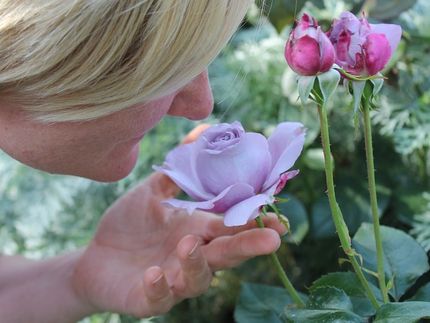Olfactory receptors discovered in bronchi
The muscle cells of bronchi detect scents, for example a specific banana and apricot scent. This might be good news for asthma sufferers.
Researchers identified two types of olfactory receptors in human muscle cells of bronchi. If those receptors are activated by binding an odorant, bronchi dilate and contract – a potential approach for asthma therapy.
This is the conclusion drawn by a team headed by Prof Dr Dr Dr habil Hanns Hatt and Dr Benjamin Kalbe at the Department for Cellphysiology in Bochum. Together with colleagues from various clinics in Bochum, Cologne and Herne, the researchers from Ruhr-Universität Bochum published their report in the journal “Frontiers in Physiology”.
Banana-apricot scent dilates bronchioles
The newly discovered receptors in muscle cells are named OR2AG1 and OR1D2. The researchers also identified the activating odorous molecules as well as the signalling pathways that are triggered in the cells.
Amyl butyrate, a fruity scent with banana and apricot notes, stimulates the OR2AG1 receptor. Once the odorant binds, bronchioles relax and dilate. In the experiment, this effect was so strong that it could reverse the effect of histamine. Histamine is the substance released by the body if a person suffers from allergic asthma, which leads to constriction of the bronchi.
Approach for asthma therapy
“Amyl butyrate may help improve airflow in asthma sufferers,” concludes Hanns Hatt. “It can probably counteract not only the effect of histamine, but also that of other allergens that make breathing difficult.” The receptor might also be of interest in the treatment of other diseases, such as chronic obstructive pulmonary disease.
The researchers demonstrated, moreover, that amyl butyrate triggers the same signalling pathways in the muscle cells as in the olfactory cells in the nose.
Second receptor with opposite effect
The second receptor OR1D2 is sensitive to scents with floral, oily notes, for example lilial or bourgeonal. If the odorant binds to the receptor, the effect is opposite to that of the OR2AG1 receptor: the bronchial muscles contract. Moreover, pro-inflammatory substances are released from the cells.
For the purpose of the study, the researchers analysed human cell cultures provided by the team headed by PD Dr Jürgen Knobloch from the University Clinic Bergmannsheil in Bochum. The studied specimens were smooth muscles that, unlike striated muscles, cannot be contracted voluntarily.
Original publication
Other news from the department science

Get the life science industry in your inbox
By submitting this form you agree that LUMITOS AG will send you the newsletter(s) selected above by email. Your data will not be passed on to third parties. Your data will be stored and processed in accordance with our data protection regulations. LUMITOS may contact you by email for the purpose of advertising or market and opinion surveys. You can revoke your consent at any time without giving reasons to LUMITOS AG, Ernst-Augustin-Str. 2, 12489 Berlin, Germany or by e-mail at revoke@lumitos.com with effect for the future. In addition, each email contains a link to unsubscribe from the corresponding newsletter.



















































